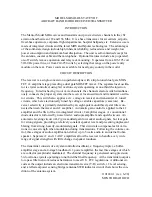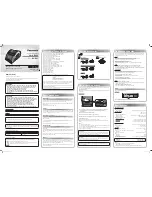
MODEL MB SOLID-STATE VHF
AIRCRAFT BAND RADIO RECEIVER/TRANSMITTER
INTRODUCTION
The Mentor Model MB receives and transmits on up to six discrete channels in the vhf
aviation band between 118 and 136 Mhz. It is a base transceiver for air carriers, airports,
fixed-base operators, corporate flight departments, hospital helipads, etc. Extensive use is
made of integrated circuits and the latest MOS and bipolar technologies. The advantages
of the solid-state design include high inherent reliability, reduced size and weight, low
power consumption and minimum heat dissipation. The unit is self-contained except for
the antenna, coaxial cable and the microphone. Optional features include a key-operated
on-off switch, remove operation and relay rack mounting. It operates from a 105-125 volt
50/60 Hz power line, or from 210-250 volts by selecting that range on the power entry
module on the rear. Power cords are available for nearly any country in the world.
CIRCUIT DESCRIPTION
The receiver is a single-conversion superheterodyne with a triple-tuned dual gate MOS-
FET r.f. amplifier stage preceding a dual gate MOSFET mixer. The separate local oscilla-
tor is crystal controlled, using 3rd overtone crystals operating at one-third the injection
frequency. In radios having two or more channels, the channel selector switch simultane-
ously connects the proper crystals into the receiver local oscillator and transmitter oscilla-
tor circuits. This switch also applies a d.c. voltage to receiver and transmitter r.f. tuned
circuits, which are electronically tuned by voltage-variable capacitors (varactors). Re-
ceiver selectivity is primarily determined by an eight-pole monolithic crystal filter con-
nected between the mixer and i.f. amplifier. Automatic gain control is applied to the r.f.
amplifier and the first of the two integrated circuit i.f. amplifier stages. A conventional
diode detector is followed by noise limiter, audio preamplifier and squelch circuits. An
automatic leveling circuit (ALC) gives added gain for weaker audio signals, but less gain
for strong signals, providing a relatively constant speaker level and preventing unpleasant
blaring from strong, heavily-modulated signals. This circuit also compensates for varia-
tions in voice strength when modulation during transmissions. Following the volume con-
trol, three stages of audio amplification deliver up to 5 watts audio to an internal 8 ohm
speaker. Separate i.f. and r.f. AGC amplifiers allow the receiver to handle a very wide
range of signal strengths with little change in speaker loudness.
The transmitter consists of a crystal-controlled oscillator, a frequency tripler, a buffer-
amplifier stage and a 4-stage broadband r.f. power amplifier, the last three stages of which
are collector (amplitude) modulated. The channel frequency is generated using precision
3rd overtone crystals operating at one-third the final frequency. At the transmitter output a
low-pass filter network reduces harmonics to meet U.S. FCC regulations. Additional cir-
cuits at the output include an electronic transmit-receive (T-R) switch, r.f. level sensing,
and a reflected-power sensing bridge (antenna SWR indicator circuit) that shows the con-
dition of the antenna system.
1101242-1
(rev.
6-98)
MENTOR RADIO CO

























